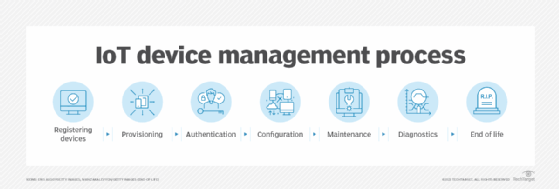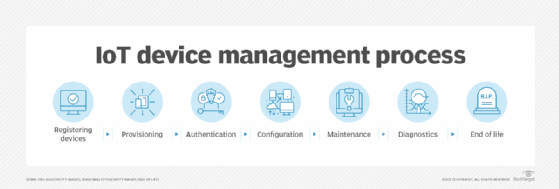
Internet of things device management (IoT device management) refers to the processes and tools used to remotely register, configure, provision, maintain and monitor connected devices from a centralized platform. IoT device management tools enable organizations to have better control of their mobile devices, while also ensuring that their devices are kept working, secure and up to date.
Many major cloud providers, such as Amazon Web Services (AWS), Google Cloud and Microsoft Azure, include IoT device management in their offerings. These platforms connect IoT devices to the cloud, where they are then accessed and managed through a central dashboard. IT administrators can access IoT device management with an internet connection from anywhere on any device.
How does IoT device management work?
IoT device management works by installing a client software agent on a device that uses a standards-based messaging protocol, such as MQTT, to communicate with the management platform. IoT device management provides control over the entire lifecycle of IoT devices.
The IoT device management process includes the following:
- Registering devices. Users must register their devices with their device management platforms before exchanging data.
- Provisioning. This involves modifying devices from their original, off-the-shelf settings to those that enable the devices to be integrated into the users’ networks.
- Authentication. This is a way for users to confirm the identities of their devices as they’re enrolled in IoT management systems. This guarantees that only authorized devices are enrolled, and it keeps sensitive corporate data secure and prevents breaches.
- Configuration. This is the process of personalizing the functionality of IoT devices. For instance, users can optimize their devices’ features with additional code, revise their devices’ settings for new requirements or add extra intelligence to their devices.
- Maintenance. IoT maintenance ensures that IoT devices in the field can be updated when necessary so they stay up to date and secure.
- Diagnostics. IoT diagnostics enable companies to monitor their connected devices closely to reduce security failures, firmware bugs and the risk of downtime. Additionally, diagnostics gives organizations the data necessary to implement predictive maintenance before minor issues become major problems.
- End of life. When individual devices become obsolete or IoT projects are finished, IoT device management is responsible for securely and cost-effectively decommissioning devices. Companies can retain the devices’ data if they are going to replace the decommissioned physical devices or archive the data if they are retiring the devices permanently.

Key features of IoT device management
The main features of IoT device management include the following:
- Easy onboarding. IoT device management software should offer a user-friendly and intuitive onboarding process that enables IT admins to easily add new devices to their systems. The software should include support for many types of devices, such as laptops, IoT devices, smartphones and tablets.
- Troubleshooting remotely. IoT device management software should enable remote troubleshooting to reduce manual efforts and resolve user issues quickly.
- Metadata management. An IoT device management platform should enable IT admins to easily view and manage each device’s metadata, e.g., the serial number, make, model and current version of the firmware. This helps with managing inventory and tracking assets.
- Analytics and reports. IoT devices generally include edge analytics capabilities. Using graphical user interface dashboards, the software can display detailed analytics insights in real time. The data can then be used to create reports for the business.
- Log management. The software should enable IT admins to view and manage the logs each device generates, which can help identify issues and track device activity.
- Security. IoT device management software should have a wide range of security features, e.g., access control, encryption and authentication, to help prevent data breaches and unauthorized access.
- Over-the-air updates. OTA updates enable IT admins to automatically push updates and patches.
Benefits of IoT device management
The main benefits of IoT device management include the following:
- Simplified process for updating devices. IoT device management enables IT admins to efficiently update many devices in a controlled, phased manner. Admins can configure devices remotely and simultaneously perform software updates for any number of devices or device groups. Not only does this save a huge amount of time, but it also ensures that users can quickly, efficiently and accurately send and receive critical information from their devices.
- Stringent security. IoT networks handle sensitive corporate and customer data. IoT device management software can help companies protect this data by implementing data encryption and segmentation. The software enables admins to manage, upgrade and update access to certain devices or device groups, ensuring that the devices and data are always secure.
- Adaptation for rapidly changing business models. IoT device management software enables companies to get the most out of their IoT platforms by enabling them to more quickly shift to new business models. By effectively managing IoT devices, organizations can create better products and services, better understand the needs of their customers and develop new sources of revenue.
- Faster IoT device registration. IoT device management offers tools to enable companies to more quickly develop, configure and deploy connected devices, enabling them to put entire networks into operation immediately.
- Enhanced device organization. Effective device management enables companies to organize devices into groups and hierarchies and manage the pertinent access policies for each group or hierarchy. This streamlines device tracking and operations and helps companies better align their devices with established security and business practices.
- Easier-to-manage remote devices. It can be difficult to access devices in the field that aren’t patched or updated. IoT device management enables admins to remotely update, as well as execute reboots, security patches and factory resets, across an entire fleet of IoT devices. In addition, IoT device management enables admins to remotely access, troubleshoot and resolve issues that individual devices might experience.
Drawbacks of IoT device management
As the number of IoT devices increases, so does the number of difficulties managing them. Some of the most common drawbacks of IoT device management are the following:
- Access control. One of the major concerns with IoT devices is security, as these devices are often left unsecured and not password-protected — making them easy targets for cybercriminals. To ensure devices, as well as sensitive corporate and customer data, are protected, companies must control who accesses their devices and their data.
IoT device management helps organizations identify, track and control how many devices are connected at any time. In addition, most IoT device management tools enable organizations to configure strong access controls. Companies should also ensure that users employ strong and unique passwords or use public key cryptography, as well as regularly update device firmware.
- Device proliferation. In addition to the challenges of managing massive numbers of IoT devices, the explosion of IoT devices can also put a strain on networks as the demand for bandwidth also increases, causing network congestion and outages. IoT device management software usually has features to enable companies to automate and centrally manage device operations.
- Fragmented data. As more IoT devices come online, it can be challenging for companies to manage the volume and variety of the data they generate, as much of it is unstructured and not easy to use. IoT device management tools can collect, organize and analyze this data.
IoT device management use cases
There are a number of IoT device management use cases, including the following.
Smart home automation
Using IoT device management cloud service platforms, homeowners can remotely manage and monitor their smart home devices, including security cameras, smart locks and thermostats, from a single location. Service providers can use IoT device management platforms to remotely troubleshoot and resolve problems.
Industrial IoT
Organizations can use IoT device management software to manage and monitor their industrial IoT devices, such as sensors and monitoring systems, to boost operations, increase productivity and reduce downtime.
Healthcare
Companies can implement IoT device management platforms to manage and monitor medical devices, including wearable health trackers and remote patient monitoring systems. And healthcare providers can use these platforms to remotely monitor the health of their patients, track whether patients are taking their medications and identify potential problems before they become serious.
Smart city infrastructure
City officials can use IoT device management to manage and monitor smart city infrastructure, including streetlights, waste management and traffic management systems. Additionally, officials can use this software to enhance operations, save money and improve their sustainability efforts by monitoring the performance of their devices and pinpointing areas for improvement.
Connected heating systems
Facility managers and residents can use IoT device management to remotely control and monitor connected heating systems in their commercial buildings and smart homes using tablets or smartphones.
Popular IoT device management software
There are many IoT device management platforms on the market. A sampling of these platforms are the following.
AWS IoT Device Management
This IoT device management software from AWS helps organizations onboard, organize, monitor and manage their IoT devices remotely. AWS IoT Device Management includes a suite of AWS IoT services from device software to control services and analytics services.
Azure IoT Hub
Microsoft’s Azure IoT Hub is an IoT device management software hosted on the Azure cloud platform. This software includes features that enable device security, provisioning and management. Azure IoT Hub also includes added services to help developers build IoT applications.
Hologram
Hologram is an IoT device management platform for any organization with a globally distributed IoT presence, which makes it challenging to effortlessly establish and manage network connections. Hologram makes it easier for companies to navigate between multiple local carriers as its cellular platform includes SIM cards that switch networks automatically, giving IoT devices coverage across more than 550 carriers in more than 190 countries.
Bosch IoT Suite
Bosch IoT Suite is an IoT device management platform based on open source projects and standards that supports a range of integration features. The tool is designed for managing connected devices at scale, making it ideal for industrial and enterprise use. Bosch IoT Suite features include the use of digital twins, mass device management, device edge management and device inventories.
Best practices for IoT device management
To ensure an organization’s IoT devices function and operate properly, a proper IoT device management process is important. Best practices that pair with IoT device management include the following:
- Maintaining security. IoT devices should be continually monitored for vulnerabilities throughout their lifecycle. Devices can be remotely patched to address security issues. Strong authentication and zero-trust policies should be followed to prevent unauthorized access or potential data breaches.
- Performing OTA updates. OTA updates are useful to patch vulnerabilities and other issues at scale, as they do not require physical access to each connected device.
- Monitoring devices. Connected IoT devices should be monitored not just to ensure security, but also to ensure device connectivity and usage, which aid in optimizing performance.
- Configuring devices. Standardizing and managing device settings upon setup helps ensure consistency, while also improving scalability.
IoT management includes many different practices and processes aimed at improving device function and health throughout its lifetime. Learn more about best practices for managing IoT at the edge.


